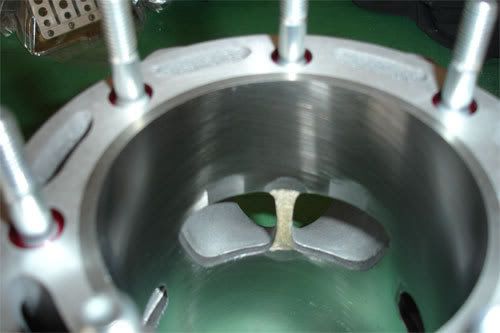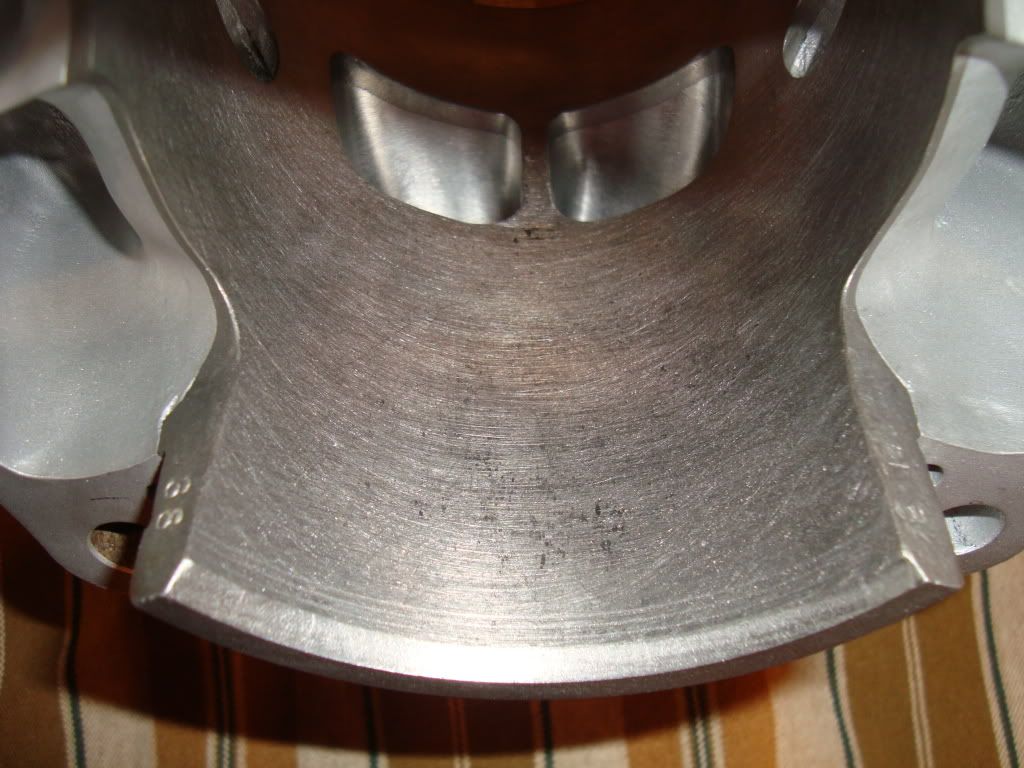
This is what you dont want to see........ notice the blowby streaking from every head stud location. This bore is shaped like a " Stop Sign".
Why? Mostly due to poor machining. I have seen several post's like " My buddy can bore and hone you jug for $35! ".... well you get what you pay for. At $35 the dude is making about $10 per hour. Pass.
Expect to pay about $60 or so for a Bore, Hone, Deburr, and Bridge Relief. And make sure the machinist uses a " Torque Plate" during the process. This is a thick plate that bolts on and simulates the cylinder head being installed during all the boring and honing operations. It stresses the cylinder to ensure its ROUND when all is said and done and the real cylinder head is bolted on. Its a very big deal if you want maximum power and longevity.
This is what a quality job looks like when you get it back.....

Notice the "+" and "-" 45 degree crosshatch, and more importantly.. the shinyness of the cylinder. Sharp tooling and quality hones " Cut " the metal away..... dull and crappy tooling " Tears" it away, or folds it over and the cylinder will look....well...... dull.
The finish may look nearly the same to the eye, but under a microscope it would look freightening. Often folks talk about "Seating the Rings". If the bore is round, the finish done properly, and quality rings are used... there is no "Break in"... its done the instant you kick it over.....
" Why is blowby bad ?" Consider the only thing that lubes the skirt and helps seal the rings is blown away ( or consumed by heat) everytime the sparkplug fires..... now think of this happening over and over... micro -seizures start to develop... more blow by, bigger micro -siezures.... more blowby...... finally...... SQUEEK!
Forged pistons seem to suffer more blowby than cast... but crappy machinework is probably more the root cause......
For those looking for some bathroom reading... Here is a Copy /Paste from Group K Racing....
"Even among mechanics, there's plenty of confusion about what causes a particular piston to seize. This confusion is compounded when the mechanic only gets to see the remnants of the meltdown instead of the entire machine. The following information will help to dispel some myths, and shed some light on the understanding of piston seizures. The objective of this article is to make piston seizures a part of your past.
Some fundamentals many people believe that piston seizures occur when engine heat causes the piston to expand larger than the size of the cylinder bore .... This is not true. If you could freeze your engine "in motion" in the middle of a long full throttle pass, and disassemble it for micrometer measurement, you would find the piston to measure at a .0005" to .0015" press fit into the bore. That's right, a slight press fit! The reason that it doesn't seize is because the premix oil has such a terrific film strength that it acts as an unremovable buffer between the piston and the cylinder. That is, the bare metal surface of the piston never actually touches the bare metal surface of the cylinder because the oil stays between them. Many mechanics have experienced this phenomenon while cleaning a freshly bored cylinder. Completely dry without cleaning solvent, the piston moves through the bore with difficulty. After rinsing the piston glides all the way through with no resistance at all. This is because the solvent acts as a film between the piston and cylinder.
A piston seizure can only occur when something burns or scrapes away the oil film that exists between the piston and the cylinder wall. Understanding this, it's not hard to see why oils with exceptionally high film strengths are very desirable. Good quality oils can provide a film that stands up to the most intense heat and the pressure loads of a modern high output engine.
The difference between seizure and scoring Seizure and scoring are two different stages of the same problem. When the oil film on a cylinder is momentarily burned or brushed away, the metal surfaces of the piston and the cylinder wall will actually touch. When this happens, there is a sort of scraping that takes place between them. When the oil film is resumed, the marks from this scraping will often remain on the piston and (or) the cylinder wall. This momentary scraping or "scoring" seldom causes any permanent or performance robbing damage. No significant damage takes place because the oil film is resumed before the piston and cylinder have a chance to start exchanging material onto one another.
Scoring is commonly seen on the piston face directly below the piston ring end gaps. The blast of combustion can get between the large end gap of a worn out ring and burn the oil off the piston and cylinder in that area...Hence the surface scoring. In most cases, score marks can simply be sanded off of the piston and cylinder. However when ever you see scoring, it's a good idea to find the source so that it doesn't develop into a full blown seizure.
Seizure is a case of scoring where the oil film does not immediately return. After a few moments of constant scoring, the piston and cylinder will scratch each other hard enough to remove material from each other. This floating material grinds itself into the piston and the cylinder as it continues to grow in size. As this snowballing material grows, it will drive the opposite side of the piston against the cylinder wall with a pressure so terrific that scoring begins to take place. While all this is going on, your engine is still running wonderfully at full throttle.
The death blow comes when the mass of material between the piston and the cylinder wall finds it's way to the piston ring. This nearly molten mixture of aluminum and iron will instantly lock the ring in it's groove. This ring locking, not the piston surface seizure, is what actually causes your engine to quit. When the piston ring becomes locked back in it's groove, it's incapable of providing compression sealing against the cylinder wall. This instant loss of compression, while the engine is at speed, causes a dramatic loss of power. That power loss, along with the added drag of the badly seized piston, makes the engine quit or lock up in a nanosecond. In fact this entire seizure process, from the first scoring scratch to the piston locked solid, takes less than a second at full rpm. That's not even enough time for you to utter the first syllable of your favorite profanity.
There are many different causes or sources for piston seizure. Each cause has it's own symptoms and it's own visual results. The following is a description of several very common types of seizures, and the most common problem source for each one. It should be understood that diagnosing piston seizures is not done with any precision by even the best engine builders. However this information may allow many of you to make a more educated and accurate guess.
Four corner seizure This is by far the most common type of seizure found . Both sides of the piston will show heavy scoring and seizure marks on each side of the wrist pin hole. The pattern of these four seizure points often appears to be a perfect square, hence the slang term "four corner". The scoring takes place in this pattern because those areas of the piston casting are the thickest. When the piston is seriously overheated, the thick areas will expand and distort the most. High output motorcycle engines usually experience this type of seizure pattern when a piston has been fitted with too little clearance.
The engine factors that have the greatest seizure related effect on operating temperature or excessive compression ratio or ignition advance, high rpm, insufficient fuel octane level, insufficient cooling, or any combination of these. Properly adjusting these same factors will have the greatest effect on total power output. The job of the professional engine builder is to find the right combination, or "blend", of these factors that will result in strong overall power output at a pace that your cooling system can keep up with. There are many mechanics and engine builders who have mastered their own combination "blend" that can get you all the power your after without risking a seizure.
A group of mismatched modifications is a first class ticket to "seizure-land". Any inexperienced individual who sets up your engine with over 200 psi of compression and advanced timing, is also guaranteeing your arrival. If your big mouthed motorcycle buddy down the street tells you that he can make any engine "roost".... You should think twice. You could be in for a very expensive lesson.
The classic lean seizure exhibits heavy scoring and seizure along the entire width of the exhaust port with only light scoring on the opposite piston faces. In lean mixture conditions, the exhaust gas temperatures escalate quickly into the meltdown stage. Those high temperature gases can compromise or completely burn off the oil film on the exhaust piston face as the exhaust port is being covered up. With the oil film weakened or gone, scoring quickly turns into seizure and ring locking.
In any situation where an engine has seized for no apparent reason, the motor should be pressure tested before any other teardown work is performed. If a mechanic does not have the equipment to pressure test your seized engine, it's very unlikely that he will have the finesse to accurately diagnose your problem either. In fact, pressure testing should be a standard finishing procedure for any major engine reassembly work. Race engines should be pressure tested no less than every 20 operating hours.
The air leak piston seizure, depending on the severity of the leak, can look like a four corner type or a lean mixture type of scoring pattern. If an engine is operating on the ragged edge of overheating, a small air leak can easily cause the extra overheating that will result in a four corner seizure. On the other hand, a huge air leak will draw in so much additional air that even an over rich engine can experience a lean type seizure at full rpm's.
Detonation seizures If a modified engine has been prepared with too much compression or spark advance, or if it's run on unacceptably low octane fuel, it will begin to "ping" or detonate. Detonation is a big subject the merits another article of it's own. For now we only need to understand that it causes a terrific amount of internal heat in a very short time, as well as physical damage to the combustion chamber. If you have ever seen the outer diameter of a cylinder head dome that looks as if it's been eaten by termites, you have seen the results of detonation. It packs a physical force that is roughly equivalent to hitting the edge of the piston crown with a full arm swing of a ball peen hammer. In a short amount of time, this detonation pounding will collapse the ring land and lock the ring in place (usually on the hotter running exhaust side of the piston). As soon as the ring is locked, the flames of combustion burn the oil film off of the cylinder wall, and the scoring/ seizure process begins. Because of the exhaust side scoring and the swift overheating caused by detonation, you'll have a 50/50 chance of a four corner seizure or a "lean mixture" appearing seizure.
Piston clearances As mentioned earlier, too little piston clearance is one of the most common " wrong " diagnoses made . Most of today's motors come brand new with cylinder clearances that are .001"-.002" over the recommended factory setup clearance. This extra clearance is an added protection against riders who don't follow the proper break-in procedure. If the clearance of a bored cylinder has been set at the factory recommended clearance, the close piston clearance by itself will not cause seizure. There is usually an added factor such as excessive compression or an air leak. If a piston if fitted with too little clearance, it will usually experience a four corner type seizure pattern. In most cases the ring will experience little or no damage. If this is the case, it's entirely safe to sand the score marks off the pistons and re-use them in the freshly honed cylinder.
Too much piston clearance can also result in piston scoring and seizure. A piston ring, in an excessively large cylinder bore, will have a very wide end gap not to mention very weak ring tension against the cylinder wall. The flame of combustion can easily burn past this weak ring seal as well as down the end gap opening itself. If this flame burns off a significant amount of the oil film on the cylinder wall, the scoring seizure process begins. Piston seizure caused by excessive clearance is much more common than you might think.
Lubrication related seizures By now it's apparent how important the oil film strength can be. Equally important is the amount of oil that is present in the engine. Most engines carry factory recommendations for oil premix ratios between 40:1 and 50:1. For the rpm's and operating temperatures of a stock engine, these mix ratios work fine. However if your rpm range is significantly raised by aftermarket modifications or bolt ons, you may need to increase your mix ratio slightly.
The total amount of time that it takes for a drop of oil to get from the carburetor, to the lower end bearings, to the top end, and out the exhaust port is called "oil migration time". As peak rpms increase, the amount of time that a drop of oil remains inside the engine is drastically shorter. In other words, a 9000 rpm race engine would need a mix ratio of about 32:1 to maintain the same internal lubrication presence that a stocker would have with a 50:1 mix. There are several oil brands that claim that their oil can provide equal lubrication at a leaner mix ratio (60:1 or 80:1) because of a claimed better lubrication quality. In my 20 years of working on racing motors, I have never experienced this to be true nor has any oil manufacturer, to my knowledge, proven it to be true. It's like running your truck on two quarts of a special oil instead of four quarts of a standard type oil. The quality cannot make up for the quantity.....Ever.
Fables and untruths cold seizure - this is by far the most over used "seizure scape goat". It some how implies that the rider ran his engine in a way that caused the failure. At least 95% of the "so called" cold seized engines that I've seen have had a very apparent problem else where in the engine that the original technician failed to see. Telling a customer that he cold seized the engine is an easy way for a mechanic to immediately reverse the guilt and the responsibility.
If a freshly bored engine or a high performance engine were started from stone cold, and then run hard at high rpm within 30 seconds of the start up, it could very likely experience a true cold seizure. This happens because the aluminum piston would experience a radically faster rate of expansion in that 30 seconds than the cylinder does. The reason for this difference in expansion rate is two fold.
First and foremost, the internal temperatures that the piston crown is exposed to at full load are on the order of 800'f -1100' f. The gases passing through the exhaust manifold ports is also in this 800'-1100' temperature range. The expansion rate caused by these temperatures is usually not a problem when the water entering the exhaust manifold is being preheated by the very hot exhaust port passages. However in the first 30 - 50 seconds of operation, these internal exhaust ports have not yet absorbed the heat that's needed to properly pre heat the cold incoming water. During the first 30 operating seconds, this cold incoming water will briefly maintain the water jacket around the cylinder at "stone cold diameter" while the piston is becoming "full temperature diameter". On engines with properly sized pistons, the difference in these diameters becomes much more than even the best oils can withstand. Any engine that has been warmed up for 60 seconds or longer, would be virtually incapable of a "cold seizure".
Me again....
Notice the one common thread of ALL siezure types is the breakdown of the oil film. This is why so many Hoons insist on running CASTOR oil products. No other oil can match the film stregnth, this is something even the Synthetic companies will admit. If avoiding siezures is all about film stregnth, well......, I guess you know what oil you need to run ......
Any other questions regarding cylinder prep and oil selection?






